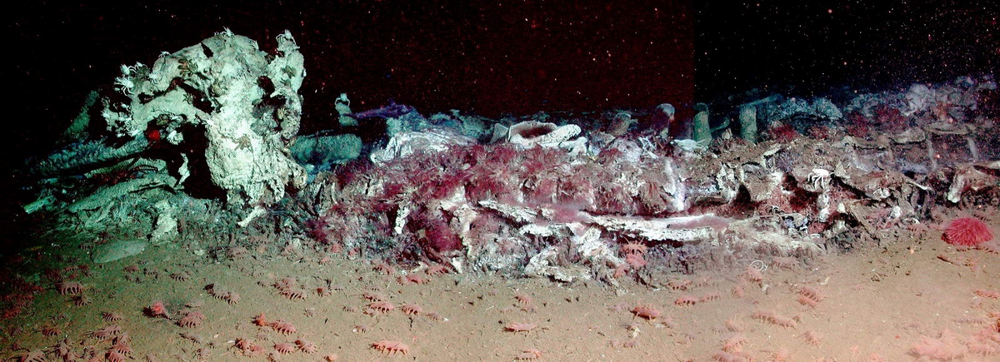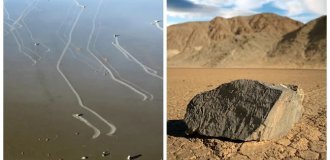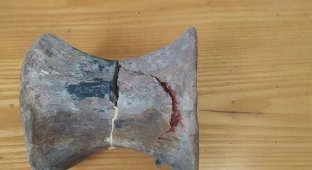When a whale dies, "flowers" bloom on its bones. And only then does it dissolve completely (8 photos)
Have you ever wondered where whale bones go? No, they don’t dissolve on their own and they don’t just lie on the bottom either. If it were like that, soon the whole ocean would become a huge cemetery! Scientists solved this mystery only 20 years ago. It turns out that the bones of all kinds of sea creatures are destroyed... by zombie worms! 
Deep-sea animals flock to the whale almost instantly. But only one creature is capable of eating the bones of the sea giant.
Osedax, carnivores, zombie worms, or literally from the Latin name “snotty flowers that eat bones,” are a very strange and very specific genus of animals from the family Pogonophora and the class of polychaete worms. True, they don’t look much like a worm at all! 
The pink fluff on the skeleton is those Osedaxes.
From a distance, a cluster of caries beetles looks like a pink field of flowers, fragrant on the bones. But no flowers grow at a depth of 3000 meters! If we look closer, we will see that each “petal” is a thin leg in a mucous capsule and several tentacle feathers on it. These mini-palms are the uppermost part of the zombie worms. It is necessary for breathing. Osedaxes do not have gills, much less lungs, so they breathe through the surface of their skin. 
What looks like a skirt is a body with a reproductive apparatus and root processes, and tentacles on top.
The rest of the worm hides in the remains that once belonged to the whale. Yes, worms live right inside the bones! But how can a tiny invertebrate crush something that the strongest jaws in the world can crush their teeth on? It's simple. If you don't have teeth, then there's nothing to break! It is not brute force that helps worms bite into bones, but knowledge of chemical processes. To penetrate inside and suck out all the bone marrow and nutritious fat, Osedax learned to cook acid. 
If children are the flowers of life, then Osedax are the flowers of death.
From sea water and their own elements they produce a caustic enzyme - carboxyanhydrase. It eats away at the surface of the bones, after which the worms send long, root-like shoots inside their bodies. Millimeter by millimeter, the roots release carboxyanhydrase and dissolve the bone structure, penetrating deeper and deeper. Anticipating questions, the caries themselves are protected from dissolution by their own acid by a thick layer of mucus. 
This jelly is the mucous capsule that protects osedax from its acid.
And you know what's funny? Carnivores can dissolve bone, but they cannot eat it! Symbiont bacteria help them obtain nutrients from the soup. These single-celled organisms live in the cells of the osedax root system and dissolve fats and collagens into easily digestible molecules. Then the worm, using the entire surface of its body, absorbs the nutritious and ready-to-eat broth. Zombie worms do not have a stomach, mouth, head, brain or other unnecessary organs. That is why, in fact, they are called that - there is nothing, but somehow they live! 
We provide free funeral services! We decorate your remains for almost free! The payment is your bones!
Moreover, they reproduce successfully and today are found in almost all seas and oceans. Scientists have not yet fully figured out how such small creatures, poorly adapted to life outside the bones, can colonize vast spaces and find unstable sources of food. According to the theory, the worms produce as many offspring as possible, give them a good start in the form of nutrient reserves in the yolk sac, and then whatever happens. If one larva swims to someone’s remains - great, no - there are still a million and one possibilities. 
Osedaxes are almost like tooth decay. Only he makes holes in all the bones!
Osedaxes do not have a mating season. It all starts when the larva settles on the bone. In most species, she automatically turns into a female and begins to actively produce eggs. The next larvae that settle nearby cling to the already transformed females and become males. To do this, they don’t need to do anything, not even eat: throughout their short lives, male carnivores will be likeparasites sit in the female's mucous capsule, feed on the reserves of her yolk sac and fertilize the eggs. Thus, up to 100 males can live in the capsule of one worm. This is where the real harem is! 
At the same time it is both living and non-living.
Zombie worms, although they seem like small and insignificant creatures, actually do a tremendous job. During its short life, the colony manages to make many holes in strong bones and eat almost all the organic matter from them. Thus, they clear the way for bacteria that feed on inorganic compounds and contribute to the creation of an entire ecosystem. Let it be small and temporary, but still.
In the long term, carnivores help close the circle of life and dispose of remains. Divers, you can thank them for not tripping over the piles of bones at the bottom right now!

























